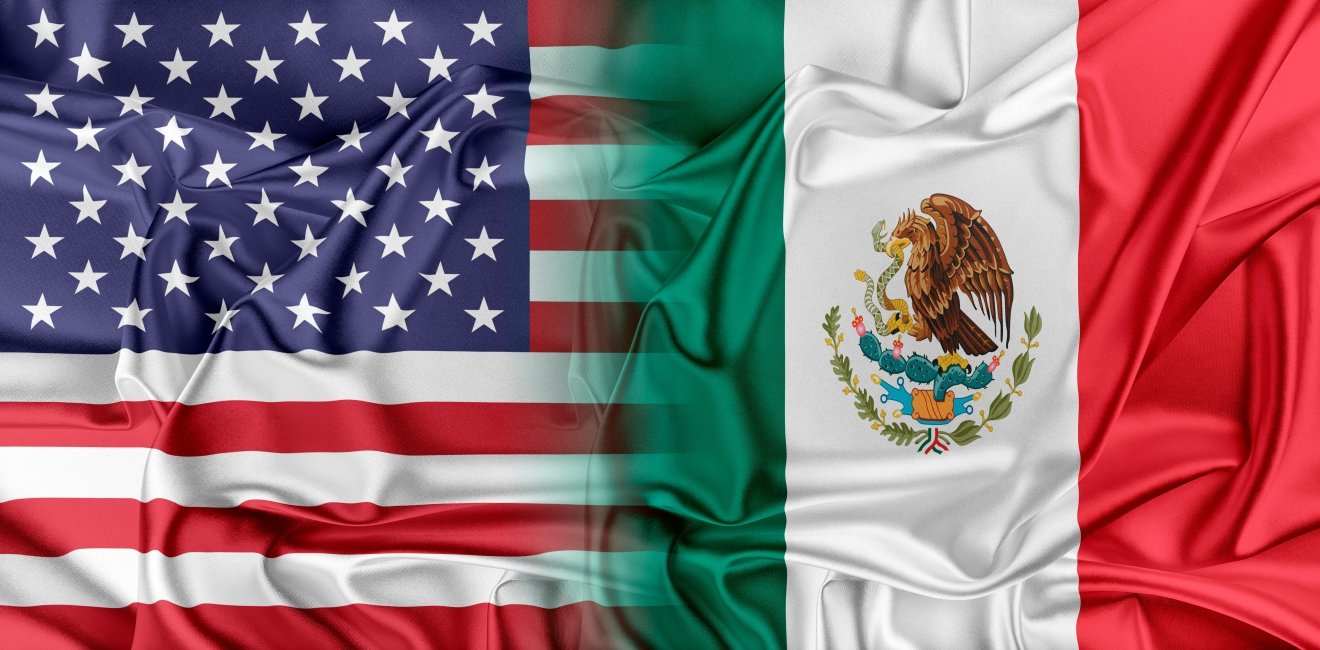Fight Cross-Border Crime with Collaboration, Not Threats
The U.S. and Mexico face a powerful onslaught of criminal activity damaging both countries. They need to step up cooperation now.
The U.S. and Mexico face a powerful onslaught of criminal activity damaging both countries. They need to step up cooperation now.

The United States and Mexico face a powerful onslaught of criminal activity damaging both countries. They need to step up cooperation now. U.S. threats are counterproductive.
What if Mexico threatened a 25 percent tariff on American corn and soybeans unless U.S. citizens stopped providing the estimated $19-29 billion in drug sale profits each year to Mexican criminal groups? Or, what if Mexico threatened to impose tariffs on American pork until the United States stops the illegal flow of automatic weapons and ammunition across the shared border?
American farmers would hardly appreciate losing parts of their number 3 export market, and Mexican consumers would lose too. Yet, Mexicans can make a very strong case that the illicit money and guns headed south from the United States are feeding the violence and corruption plaguing their country. Mexican threats would not be a constructive way to tackle “shared” problems like cross-border criminal organizations.
The recent U.S. threats to put a 25 percent tax on Mexican car imports to the United States, “if the drugs don’t stop or largely stop” are counter-productive to building the deeper cooperation needed. Those “Mexican cars” have on average 38 percent U.S. content. How many U.S. workers would be hurt, in addition to the harm in Mexico?
Without doubt, the United States and Mexico need to urgently revitalize their partnership against cross-border crime, however. The trafficking of drugs, arms, people, and money harms and kills far too many on both sides of the border. The way to progress is for both governments to improve day-to-day collaboration and strategic cooperation.
A taskforce of Mexican and American scholars and former officials developed thirteen recommendations recently to take this vital work forward. The U.S.-Mexico Security Cooperation Taskforce reviewed the last ten years of work between the two countries and suggests steps to enhance the campaign against the criminal organizations that are killing tens of thousands in both countries.
We must be clear: U.S.-Mexico cooperation cannot solve the U.S. drug demand problem that leads to some 70,000 American overdose deaths a year. Nor can bilateral cooperation solve the crime and violence in Mexico that caused 33,000 homicides in 2018. However, better bilateral cooperation can strongly augment the capability of both partners to tackle the immense problems they face.
Building mutual understanding and trust, rather than threatening the other neighbor, is essential for the boost that good bilateral collaboration will bring.
The U.S.-Mexico Security Cooperation Taskforce argues for setting up a senior-level coordination group, as well as stressing the value of collaborating at federal and state levels and the need to strengthen criminal justice and joint investigations. Also emphasized is the importance of building international liaison units and creating a special U.S.-Mexico taskforce focused on the growing threat from fentanyl. The report encourages exchanging best practices on drug abuse prevention and harm reduction strategies; initiating community policing collaboration; enhancing cooperation against Central American criminal groups; avoiding clashes over marijuana policy; using better vetting techniques against corruption; establishing mechanisms for regular, frank dialogue on human rights; and resurrecting and strengthening systematic collaboration against weapons trafficking and money laundering.
At the top of the list is the urgent need to create a cabinet-level led coordination group to power and guide the deeper collaboration needed. This body would first reconcile the top public security priorities of the two governments and set up an agreed action agenda. The group and its supporting inter-agency teams would identify key areas for deeper cooperation. The senior-level group would then carry out the vital task of regularly monitoring and reviewing progress, addressing problems that arise, and reporting to the two Presidents.
A top priority for President Trump is to stop the flow of opioids and other deadly drugs from Mexico that contribute to the addiction and overdose epidemic in the United States, while President López Obrador (AMLO) has as a top priority reversing the plague of violent homicides across large swaths of Mexico that caused record numbers of deaths in 2017 and 2018, and during the first three months of 2019 under his administration. A new report by the Institute for Economics and Peace puts the economic impact of violence at $268 billion in 2018. That is equivalent to 24 percent of Mexico’s GDP. The report catalogues how the impact of violence increased in 2018, while initial homicide statistics in 2019 show worsening numbers. It is no wonder that AMLO places a high priority on reducing crime and violence given his hope to generate more prosperity.
Though distinct, the Mexican and U.S. priorities have significant overlap. For example, Mexican drug dealers do not stand at the border and slingshot the drugs into Chicago and Boston. There are cooperating criminal networks distributing the drugs in the United States. And, the flow of money and guns from the north to Mexican criminal groups exacerbate contexts of chronic violence that certainly makes it harder to restore peace in troubled communities.
It is thus urgent for both countries that a common agenda for joint action and mutual assistance be hammered out. Without such an effort, bilateral cooperation is likely to be scattershot, episodic, and ineffective, and periodic blowups are more probable. With an agreed bilateral strategy and action agenda and a well-functioning cabinet-level group to review progress and problems regularly, the two countries have a much better chance of making progress toward the public security priorities of each. This could include a fresh look at the “Merida Initiative” which has served as the umbrella for U.S. capacity building assistance to Mexico over the last decade.
Among the taskforce recommendations for joint work is helping Mexico strengthen its federal and state law enforcement and justice forces, so they can be more effective partners in tackling crime. Mexico is building a new National Guard to help restore order throughout their country. This will be a complicated and resource-intense process. The National Guard would benefit from specific training and technical assistance provided by the United States under a joint program, whether it retains the name “Merida” or not.
Mexico’s border services, just like their U.S. counterparts, would also benefit greatly from Merida program funded “state of the art” sensors to find drugs, arms, and money crossing the border. And, Mexican as well as U.S. companies would benefit from better jointly-developed plans to assure secure and rapid trading corridors.
A big weakness for Mexico over the last decade has been its inept state and municipal police and criminal justice systems. These institutions could benefit greatly from re-targeted Merida technical assistance to improve results against criminal groups, perhaps prioritizing bilateral cooperation against groups with cross-border operations. Bilateral collaboration and capacity building need to encompass such sub-federal elements in order to support long term solutions to crime.
The taskforce argues that trusted joint investigative and liaison units should be established or reactivated to go after criminals, develop the evidence, and make the cases needed to convict them in either country. Mexico‘s criminal justice system is plagued by very low rates of convictions as well as by corruption. (Only 7 percent of crimes committed in 2017 resulted in a criminal investigation, for example, according to the 2019 Mexico Peace Index.)
The taskforce suggests two areas for specific focused work by bilateral teams: 1) tackling synthetic opioids, such as fentanyl, because it is so lethal, highly profitable, and easy to smuggle (other man-made drugs, chemical precursors, and natural opioids should also be on the priority list); and 2) tracking and seizing the money from U.S. drug sales that flows to criminals in Mexico. So far, neither U.S. nor Mexican efforts have been very successful in finding the vast amounts of money that law enforcement officials think is being collected in the United States.
The United States and Mexico should work to target criminal groups not by merely by going after the kingpins, but rather by rounding up as much of their network of both sides of the border, in large operations built on good intelligence and joint prosecution. While these operations take time to develop and require trust by U.S. and Mexican joint taskforces, they can significantly weaken the operational capacity of criminal groups.
The Taskforce report suggests other important specifics steps needed for progress, such as proper vetting of participating officials, which will help build mutual trust and effectiveness. Key, however, is agreeing on an overall strategy and an action agenda, and then setting up the liaison and working arrangements to undertake the capacity building and law enforcement work in ways that generate trust and produce results.
The law enforcement, public security, intelligence, and justice entities from both countries span many agencies. They often do not cooperate or communicate optimally within their own governments, let alone bilaterally. Over the past decade, however, the United States and Mexico have forged binational teams that have cooperated well with mutual trust, and they have improved multi-agency communication and cooperation. That experience needs to be deepened and widened across both governments. It should be targeted at tackling the most problematic areas, including arms trafficking, corruption, and human rights abuses. This can be done with clear direction and commitment from the top. And, it should be done now.
Both countries will enormously benefit from increasing the practical day-to-day work of building more effective partnerships and increasing partner capacities under the active leadership of a well-functioning senior-level coordination group.
With an agreed set of priorities, a shared strategic vision, and the political will, the United States and Mexico can forge stronger and more effective cooperation against the devastating cross-border crime harming both societies. The Mexican and American people stand to gain much from such reinvigorated cooperation.
This article was originally published in Spanish in Milenio...




The Mexico Institute seeks to improve understanding, communication, and cooperation between Mexico and the United States by promoting original research, encouraging public discussion, and proposing policy options for enhancing the bilateral relationship. A binational Advisory Board, chaired by Luis Téllez and Earl Anthony Wayne, oversees the work of the Mexico Institute. Read more


